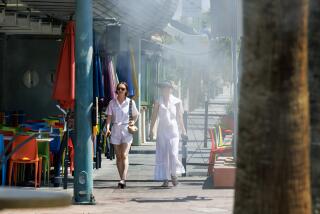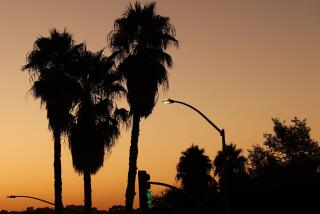This June Is Working on a Record for Weirdness
- Share via
This is supposed to be June Gloom. That’s what the month between May and July is ordinarily called in San Diego. But in looking for a word to describe this June, gloom just isn’t a strong contender.
Local experts suggest maybe a new name is needed.
June Weird?
As San Diego broke a record for heat Wednesday--the high at Lindbergh Field reached 91 degrees, surpassing the mark of 1976--the weathered weather types scrambled to find out why.
“This has certainly been an unusual month,” said Dan Atkin, meteorologist with the National Weather Service. “It’s been the wettest June ever in San Diego, and that was from one storm. And now we’ve got this heat.”
Atkin said San Diego received 0.38 of an inch of rain on June 9, followed by 0.48 of an inch the next day, breaking two daily records. The accumulated 0.86 of an inch set a monthly record.
“In average years,” Atkin said, “June is our cloudiest month of the year. On the average, the smallest amount of possible sunshine we receive in San Diego is 57%. We don’t have complete figures yet, but this June has been much sunnier than normal.”
Atkin said the traditional June Gloom is caused by a blast of heat welling up from the desert and coming into conflict with “very cool air over the water. At the same time, high pressure is starting to form, which traps the marine air. In July and August, we usually break through the (temperature) inversion, and it gets much, much hotter. This year, it happened earlier.”
Atkin said the temperature this time of year usually hovers around 73 degrees. He speculated that part of the extreme conditions, not just here but nationally, is caused by El Nino and the greenhouse effect. Not just summers, but winters, too, Atkin said, are now more severe.
Bill Hibbert, a meteorologist with Weatherdata Inc. in Wichita, Kan., which supplies weather information for The Times, believes the greenhouse effect and El Nino--as well as its “female” counterpart, La Nina--have had a profound effect on weather nationwide, particularly in the Southwest.
Hibbert defines the greenhouse effect as “man’s influence on the environment, where industrial processes and consumer excesses have generated gases that tend to absorb solar radiation rather than let it transfer freely.”
“El Nino is the shifting of temperatures on the surface of the sea,” Hibbert said. “People generally don’t recognize that oceans cover three-fourths of the planet’s surface, receiving three-fourths of the sunlight that shines on the Earth at any given time. Normally, El Nino affects Southern California with much wetter weather.
“What people don’t know as much about is La Nina, which imposes the opposite condition. That produces a cooling of (ocean) surface temperatures, resulting in excessively dry weather, which you’re now having in Southern California,” he said.
“Both can be equally virulent, especially with both occurring in conjunction with other weather patterns. What you have to remember is, with weather, nothing stands alone--everything is interconnected. And, whatever the connection is, at the moment, it’s producing extreme heat and very dry conditions in Southern California.
“But believe me, it’s hardly as bad as Wichita, where I am. I’ll trade with you any time.”
More to Read
Sign up for Essential California
The most important California stories and recommendations in your inbox every morning.
You may occasionally receive promotional content from the Los Angeles Times.










